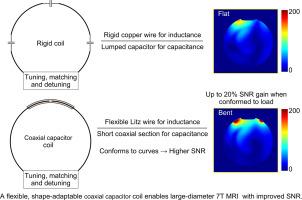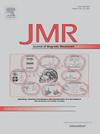用于超高场MRI的柔性和可调形状同轴电容器(COCA)线圈:与刚性线圈的比较分析
IF 1.9
3区 化学
Q3 BIOCHEMICAL RESEARCH METHODS
引用次数: 0
摘要
柔性射频线圈提高了患者的舒适度,增加了填充系数,使其对MRI具有吸引力。然而,在7 T下实现大直径柔性线圈的第一模共振仍然是一个挑战。我们提出了一种同轴电容器(COCA)线圈,它的直径可以是10厘米,仍然在298 MHz的第一谐振模式下工作。与依靠自共振的同轴电缆线圈不同,COCA线圈结合了超软利兹线的电感和短同轴结构的电容。台架测试表明,1电容器COCA线圈具有与具有3个分布式集总电容器的传统刚性线圈相当的调谐/匹配鲁棒性、有效失谐和元件间去耦性能。磁共振成像显示了高信噪比,特别是当线圈符合负载的曲率时,与平面配置相比,信噪比提高了20%。线圈在不同形状之间保持调谐和匹配的能力也支持了形状可调阵列的发展。通过使灵活的大直径线圈在超高场的第一共振模式下工作,COCA设计为具有复杂几何形状的解剖成像提供了一个有前途的解决方案,例如肩部,足部和脊柱。本文章由计算机程序翻译,如有差异,请以英文原文为准。

Flexible and shape-adjustable coaxial capacitor (COCA) coils for ultrahigh field MRI: a comparative analysis with rigid coils
Flexible RF coils enhance patient comfort and increase filling factors, making them attractive for MRI. However, achieving first-mode resonance at 7 T for large-diameter, flexible coils remains a challenge. We present a coaxial capacitor (COCA) coil, which can be 10 cm in diameter and still operates in the first resonant mode at 298 MHz. Unlike coaxial cable coils that rely on self-resonance, the COCA coil combines ultrasoft Litz wire for inductance with a short coaxial structure for capacitance. Bench tests showed that a 1-capacitor COCA coil provides comparable tuning/matching robustness, effective detuning, and inter-element decoupling performance to conventional rigid coils with three distributed lumped capacitors. MRI acquisitions demonstrated high SNR, especially when the coil conformed to the curvature of the load, with up to 20 % SNR improvement over flat configurations. The coil's ability to retain tuning and matching across different shapes also supports the development of shape-adjustable arrays. By enabling flexible, large-diameter coils to operate in the first resonant mode at ultrahigh fields, the COCA design offers a promising solution for imaging anatomies with complex geometries, such as the shoulder, foot, and spine.
求助全文
通过发布文献求助,成功后即可免费获取论文全文。
去求助
来源期刊
CiteScore
3.80
自引率
13.60%
发文量
150
审稿时长
69 days
期刊介绍:
The Journal of Magnetic Resonance presents original technical and scientific papers in all aspects of magnetic resonance, including nuclear magnetic resonance spectroscopy (NMR) of solids and liquids, electron spin/paramagnetic resonance (EPR), in vivo magnetic resonance imaging (MRI) and spectroscopy (MRS), nuclear quadrupole resonance (NQR) and magnetic resonance phenomena at nearly zero fields or in combination with optics. The Journal''s main aims include deepening the physical principles underlying all these spectroscopies, publishing significant theoretical and experimental results leading to spectral and spatial progress in these areas, and opening new MR-based applications in chemistry, biology and medicine. The Journal also seeks descriptions of novel apparatuses, new experimental protocols, and new procedures of data analysis and interpretation - including computational and quantum-mechanical methods - capable of advancing MR spectroscopy and imaging.

 求助内容:
求助内容: 应助结果提醒方式:
应助结果提醒方式:


